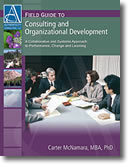Basic Overview of Life Cycles in Organizations
© Copyright Carter
McNamara, MBA, PhD, Authenticity Consulting, LLC.
This Article is in a Series About Understanding Organizational Structures and Design
This article is the fourth in the series which includes:
1. What is an Organization?
2. What Makes
Each Organization Unique
3. How They’re the Same: They’re Systems
4. Basic Overview of Life Cycles in Organizations
5. Basic Overview of Organizational Culture
6. Legal Forms and Traditional Structures of Organizations
7. Driving Forces and a New Organizational Paradigm
8. Emerging Nature and New Organizational Structures and Design
9. Basic Guidelines for Organizational Design
10. Wrap
Up: Grasping the Big Picture in Organizations (video)
Sections of This Article Include
What Are Organizational Life Cycles?
Why Are They Important to Understand?
Example of a Simple Organizational Life Cycle Model
Product Life Cycles
Additional Perspectives on Life Cycles
What Are Organizational Life Cycles?
Simply put, organizations are social systems. They’re groups of people organized
around a common purpose. Their activities include similar recurring practices,
for example, strategic planning, business planning, product and service development,
marketing, financial management and evaluations. Each activity usually includes
formally or informally clarifying goals, taking steps toward those goals, deciding
if the goals are being met or not, and adjusting activities to be even more
effective and efficient in reaching the goals. The social systems can be focused
primarily on the entire organization, teams, each product or service, or within
a certain activity. Individuals themselves are systems, needing a clear purpose
and activities to continually work toward that purpose.
Social systems go through common life-cycles ranging from, for example, from
start-up to growth to maturity. For example, as people mature, they begin to
understand more about the world and themselves. Over time, they develop a certain
kind of wisdom that sees them through many of the challenges in life and work.
They learn to plan and to use a certain amount of discipline to carry through
on those plans. They learn to manage themselves. Meanwhile, they go through
infancy, child-hood and early-teenage phases that are characterized by lots
of rapid growth. People in these phases often do whatever it takes just to stay
alive, for example, eating, seeking shelter and sleeping. Early on, many people
tend to make impulsive, highly reactive decisions based on whatever is going
on around them at the moment.
Why Are They Important to Understand?
Start-up organizations, team and internal practices are like this, too. Often,
founders of the organization or program and its various members have to do whatever
is necessary just to stay in business. Leaders make highly reactive, seat-of-the-pants
decisions. They fear taking the time to slow down and do planning.
Experienced leaders have learned to recognize the particular life cycle that
a system is going through. These leaders understand the types of problems faced
during each life cycle. That understanding gives them a sense of perspective
and helps them to decide how to respond to decisions and problems in the workplace
and their lives and the workplace.
That understanding also suggests the priories that they need to soon address
in order to evolve to the next stage. Systems that do not evolve often stagnate
or decline between stages. Symptoms can be unclear priorities, unclear roles,
increasing frustrations and conflict, and people leaving the organization. If
the understanding of the life cycle is not known, then these problems are often
not resolved.
When discerning the particular stage that a system is currently in, it does
not depend on the age of the system. Rather, it depends on the nature of its
current activities. For example, if the activities are mostly unplanned, high
reactive and decisions are made primarily by certain personalities rather than
by plans and policies, then that organization is operating more like an early
stage organization.
Example of a Simple Organizational Life
Cycle Model
Life cycles of social systems are so important to understand that there has
been an increasing number of suggested frameworks and models for life cycles.
Here is one simple model to further enhance your understanding of life cycles.
In this example, the focus is on an organization-wide social system.
Some systems planners consider there to be an additional stage of decline that
is after the maturity stage. That stage recognizes that not all systems are
meant to exist forever. It also helps systems planners to avoid desperately
staying in the maturity stage, lest the system “fails”.
Start-Up Features
- Has compelling, exciting vision and purpose
- People are motivated by exciting, charismatic leaders
- Board is usually a hands-on (working) Board
- People are recruited because they’re excited and want to chip in
- People chip in wherever they feel they’re needed
- Decisions are often reactive and spontaneous. Plans, if developed at all, are often not implemented
- Resources (money, facilities, etc.) are continually sought, sometimes in crisis situations
- Occasional confusion, frustration and conflicts can exist about who’s doing what, how and when
- People begin to talk about the need for more planning and procedures
- If there’s strong resistance to change, then crises increase, for example, cash shortages, conflicts and people leaving
Priorities in Growth Stage
- Focus is on strengthening internal systems to support growth, while expanding services and markets
- Leaders focus on managing change as much as on generating new ideas
- Board evolves to more of a policy-Board with continued focus on plans, policies and full participation
- Different departments and teams are appropriately coordinated for efficiencies
- Planning is regular and systematic, and focused on goals, roles and deadlines
- Progress is regularly monitored for status, learning and continuous improvement
- Regular and routine activities are proceduralized for reliability and efficiencies
- Internal systems are developed to systematically obtain resources, based on plans
- Performance management practices are focused on personnel and the organization
Priorities in Maturity Stage
- Focus in on sustaining momentum and renewal, especially to avoid entrenching in bureaucracy
- Focus is also on creativity and innovation – sometimes to start new ventures, that start new life cycles themselves
- Management priorities are especially on succession planning and risk management
- More learning is shared with other people and organizations
- Leaders seek to successfully duplicate their business model elsewhere
- People attend to even longer-range planning, for example, 3-5 years out
- Priority continues to be on managing change and transformation
- Some organizations consider terminating the organization if its vision is achieved
Product Life Cycles
The recurring activities to plan, develop, implement, evaluate and then adjust
the plans for each product and service is a essentially a systematic recurring
set of activities. It is a system and has a life cycle like many other systems.
The phases in the system might be described by the above simple diagram of phases.
Experienced product managers understand the stages of development of a typical
product or service, and know what the typical traits of each stage are. Thus,
they know what priorities to address to evolve the product or service to maturity.
They understand that problems that can occur if the next stage is not reached.
Consider the following articles.
Product Life Cycle Stages
Product
Life Cycle diagrams
Product life cycle
(Wikipedia)
Best
Practice Report: Product Lifecycle Management
What
is the Product Life Cycle? Definition and Examples
Ultimate
Product Life Cycle Management Guide
Product
Life Cycle Examples
Exploit
the Product Life Cycle
Additional Perspectives on Life Cycles
Organizational
Life Cycles (Wikipedia)
The
Five Phases Organizational Life Cycle
Five
Life Stages of Nonprofit Organizations
Life
Cycles of an Organization
Organizational
Life Cycles (it helps to see different diagrams)
Barbarians to Bureaucrats
Life
Cycle Approach to Strategic Planning (in-depth and dated, but relevant)
Also consider
Systems Thinking,
Systems Tools and Chaos Theory
Entrepreneurship
— Product and Service Development
Learn More in the Library’s Blogs Related to Organizations
In addition to the information on this current page, see the following blogs
which have posts related to organizations. Scan down the blog’s page to see
various posts. Also see the section “Recent Blog Posts” in the sidebar of the
blog or click on “next” near the bottom of a post in the blog.
Library’s
Consulting and Organizational Development Blog
Library’s
Leadership Blog
Library’s
Nonprofit Capacity Building Blog
For the Category of Organizational Development:
To round out your knowledge of this Library topic, you may want to review some related topics, available from the link below. Each of the related topics includes free, online resources.
Also, scan the Recommended Books listed below. They have been selected for their relevance and highly practical nature.











